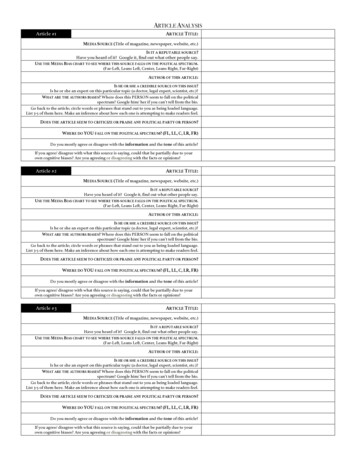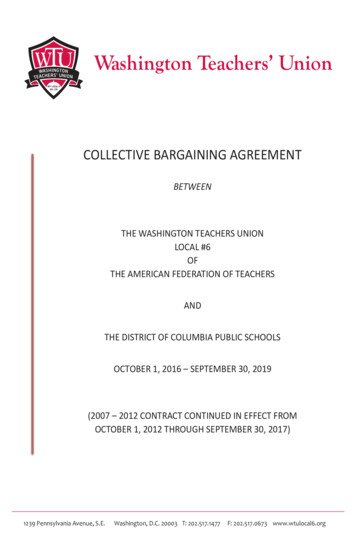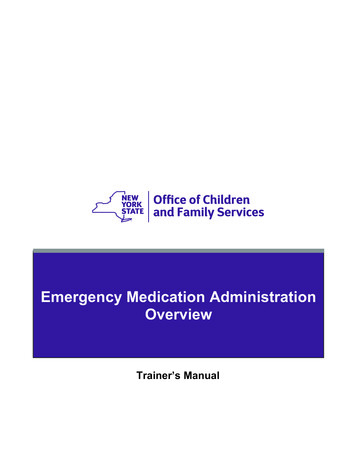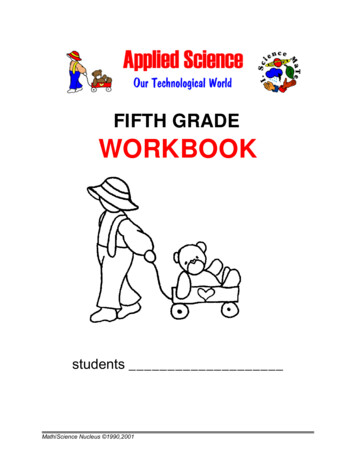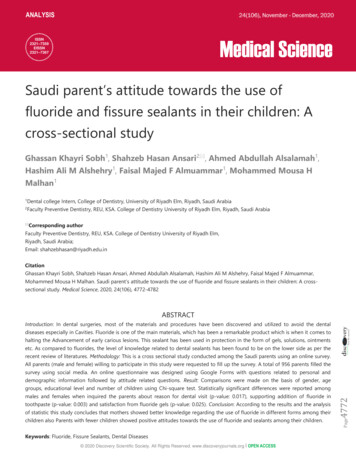
Transcription
ANALYSISANALYSIS24(106), November - December, 2020ARTICLEMedical ScienceISSN2321–7359EISSN2321–7367Saudi parent’s attitude towards the use offluoride and fissure sealants in their children: Across-sectional studyGhassan Khayri Sobh1, Shahzeb Hasan Ansari2 , Ahmed Abdullah Alsalamah1,Hashim Ali M Alshehry1, Faisal Majed F Almuammar1, Mohammed Mousa HMalhan11Dentalcollege Intern, College of Dentistry, University of Riyadh Elm, Riyadh, Saudi Arabia2FacultyPreventive Dentistry, REU, KSA. College of Dentistry University of Riyadh Elm, Riyadh, Saudi ArabiaCorresponding author Faculty Preventive Dentistry, REU, KSA. College of Dentistry University of Riyadh Elm,Riyadh, Saudi Arabia;Email: shahzebhasan@riyadh.edu.inCitationGhassan Khayri Sobh, Shahzeb Hasan Ansari, Ahmed Abdullah Alsalamah, Hashim Ali M Alshehry, Faisal Majed F Almuammar,Mohammed Mousa H Malhan. Saudi parent’s attitude towards the use of fluoride and fissure sealants in their children: A crosssectional study. Medical Science, 2020, 24(106), 4772-4782ABSTRACTIntroduction: In dental surgeries, most of the materials and procedures have been discovered and utilized to avoid the dentaldiseases especially in Cavities. Fluoride is one of the main materials, which has been a remarkable product which is when it comes tohalting the Advancement of early carious lesions. This sealant has been used in protection in the form of gels, solutions, ointmentsetc. As compared to fluorides, the level of knowledge related to dental sealants has been found to be on the lower side as per therecent review of literatures. Methodology: This is a cross sectional study conducted among the Saudi parents using an online survey.All parents (male and female) willing to participate in this study were requested to fill up the survey. A total of 956 parents filled thesurvey using social media. An online questionnaire was designed using Google Forms with questions related to personal anddemographic information followed by attitude related questions. Result: Comparisons were made on the basis of gender, agetoothpaste (p-value: 0.003) and satisfaction from fluoride gels (p-value: 0.025). Conclusion: According to the results and the analysisof statistic this study concludes that mothers showed better knowledge regarding the use of fluoride in different forms among theirchildren also Parents with fewer children showed positive attitudes towards the use of fluoride and sealants among their children.Keywords: Fluoride, Fissure Sealants, Dental Diseases 2020 Discovery Scientific Society. All Rights Reserved. www.discoveryjournals.org l OPEN ACCESSPagemales and females when inquired the parents about reason for dental visit (p-value: 0.017), supporting addition of fluoride in4772groups, educational level and number of children using Chi-square test. Statistically significant differences were reported among
ARTICLEANALYSIS1. INTRODUCTIONDental problems among children can be avoided if appropriate preventive measures can be taken. In order to achieve this, parentsmust play their role by making regular visits to the dentist. Prior knowledge about prevention needs to be adequate if successfulprovision of dental prophylaxis is to be implemented (Mejàre et al., 2015; Marinho et al., 2015; Milgrom et al., 2018). Similarly, pitand fissure sealants have also been used for a long time now to provide protection from dental caries among children. These areflowable materials with varying properties that have been playing an important role in preventing dental caries especially amongchildren. Success rate has been found to be higher when applied at the right age and time (Ahovuo-Saloranta et al., 2017; Wright etal., 2016).Awareness of parents towards the application of these preventive measures among their children is of high importance. Severalstudies have shown that the parents do have the knowledge of fluoride use as a preventive armory among their children. However,not many parents are able to convert this knowledge into practice. Surprisingly, some parents have also reported to have refusedthe fluoride application due to the risk of toxicity or weak beliefs (Chi, 2017; Djordjevic, 2018). As compared to fluorides, the level ofknowledge related to dental sealants has been found to be on the lower side as reported in previous studies. Less knowledge hasresulted in lower number of children receiving dental sealants. Differences between mothers and fathers have also been observed ina few studies, where mothers’ attitude was found to be comparatively positive (Lakshmanan and Gurunathan, 2020; Lenčová andDušková, 2013).Study HypothesesMothers show positive attitude towards the use of fluorides and sealants as compared to fathers.Aims of the studyTo determine the attitude of Saudi parents regarding the use of fluorides and fissure sealants in their childrenTo compare the attitude level between mothers and fathersTo determine the factors associated with negative attitude towards the use of fluoride and sealants2. MATERIALS AND METHODSEthical approvalThe study proposal was registered in the research centre of REU, and ethical approval was obtained with registration numberFRP/2020/287/327/321. Informed consent to participate in the study was obtained from the subjects before start of the study. Thestudy was conducted for 3 months between July 2020 to October 2020.Study DesignThis is a cross sectional study conducted among the Saudi parents using an online survey.Study SampleAll parents (male and female) willing to participate in this study were requested to fill up the survey. A total of 956 parents filled thesurvey using social media.Study InstrumentAn online questionnaire was designed using Google Forms with questions related to personal and demographic informationfollowed by attitude related questions.Instrument Validity and ReliabilityA pilot study was conducted by sending the survey to 20 parents and the data were inserted in SPSS version 22 to determine theStatistical AnalysisCollected data was analyzed using SPSS version 22, where descriptive as well as inferential statistics was conducted. Comparisonsbetween groups will be made by conducting Chi-Square test with the value of significance kept under 0.05. 2020 Discovery Scientific Society. All Rights Reserved. www.discoveryjournals.org l OPEN ACCESSPageREU but no changes were made.4773reliability by using Chronbach’s coefficient alpha. Validity of the questionnaire was tested by sending it to experienced researchers in
ARTICLEANALYSIS3. RESULTSReliability of QuestionnaireChronbach’s Alpha: 0.744The results table 1 -5 and figure 1 revealed that a total of N 956 parents participated in this study, which included n 335 (35%)males and n 621 (65%) females. Age variations were reported to be n 322 (33%) 18-30 years, n 350 (36%) 31-45 years, n 251(26%) 46-60 years and n 42 (4%) 60 years. Participants were also grouped on the basis of educational level with n 72 (8%)primary, n 131 (14%) intermediate, n 230 (24%) secondary and n 526 (55%) university qualified. As far as the number of childrenwere concerned, n 343 (37%) had 1-2 children, n 387 (42%) had 3-5 children and n 186 (20%) had 6 children.Comparisons were made on the basis of gender, age groups, educational level and number of children using Chi-square test.Statistically significant differences were reported among males and females when inquired the parents about reason for dental visit(p-value: 0.017), supporting addition of fluoride in toothpaste (p-value: 0.003) and satisfaction from fluoride gels (p-value: 0.025).As far as age groups comparison was concerned, significant associations were reported when inquired the parents about reasonfor dental visit (p-value: 0.002), source of information about oral health (p-value: 0.000) and satisfaction from fluoridated water (pvalue: 0.043). Educational levels were also compared and significant comparisons were obtained for all questions except satisfactionfrom fluoride gels (p-value: 0.239) and fluoridated mouth rinse (p-value: 0.379).Table 1 Demographics of study participantsGender:Male335 (35%)Female621 (65%)Age:18-30 Years322(33%)31-45 Years350(36%)46-60 Years251 (26%)60 Years42 (4%)Education level:Primary72(8%)Intermediate131 (14%)Secondary230 (24%)University526 (55%)Number of Children:1-2 Children343 (37%)3-5 Children387 (42%)6 Children186 (20%)Use of Fluoride and Fissure ateSecondaryUniversityFigure 1 Use of Fluoride and Fissure Sealants in children. 2020 Discovery Scientific Society. All Rights Reserved. www.discoveryjournals.org l OPEN ACCESS47748%Page20%
ANALYSISARTICLETable 2 Comparison on the basis of GenderItemMaleFemaleLess than 6 monthsLess than 6 months39%44%6 to 12 months6 to 12 months31%27%12 months12 months24%24%Never visitedNever visited6%5%Check upCheck up29%22%EmergencyEmergency51%60%Routine TreatmentRoutine TreatmentP- ValueDental HistoryDate of last dental visitReason for dental visit19%19%Personal use of fluorideRegular BasisRegular Basisrinses40%34%Private DentistPrivate Dentist34%43%InternetInternetSource of information37%32%about oral healthTV/ NewspaperTV/ Newspaper13%11%Friends/ FamilyFriends/ Family17%14%0.4230.0170.0670.059Parents’ attitude towards fluoride and sealants use among their childrenForFor39%37%AgainstAgainstTopical fluoride13%13%productsDon’t KnowDon’t Know41%41%No ReplyNo Reply8%9%ForFor32%29%AgainstAgainst13%13%Don’t KnowDon’t Know46%45%No ReplyNo Reply10%12%0.669Page4775Water fluoridation0.925 2020 Discovery Scientific Society. All Rights Reserved. www.discoveryjournals.org l OPEN ACCESS
ARTICLEANALYSISFluoride toothpasteForFor47%56%AgainstAgainst9%12%Don’t KnowDon’t Know36%26%No ReplyNo Reply8%6%0.003Satisfaction levels from different means of caries preventionFluoridated waterFissure sealantsFluoridated gelsFluoridated mouth %0.7490.0590.0250.112Table 3 Comparison on the basis of Age GroupsItem18-30 Years31-45 Years46-60 Years60 YearsLess than 6Less than 6Less than 6Less than 6monthsmonthsmonthsmonths45%40%43%26%6 to 126 to 126 to 126 to 12monthsmonthsmonthsmonthsDate of last25%31%27%33%dental visit12 months12 months12 months12 months22%23%27%31%Never visitedNeverNever visitedNever7%visited3%visitedP- ValueDental History10%Check upCheck upCheck Reason for51%56%67%45%dental tTreatmentTreatment20%18%18%24%Regular netPersonal use offluoride rinsesSource ofinformationabout oral health0.0020.2574776Check up0.000 2020 Discovery Scientific Society. All Rights Reserved. www.discoveryjournals.org l OPEN ACCESSPage5%0.099
3%Parents’ attitude towards fluoride and sealants use among their nstAgainst12%15%12%10%Don’t KnowDon’t KnowDon’t KnowDon’t Know43%40%40%36%No ReplyNo ReplyNo ReplyNo stAgainstAgainst12%15%12%12%Don’t KnowDon’t KnowDon’t KnowDon’t Know45%46%46%36%No ReplyNo ReplyNo ReplyNo instAgainstAgainst11%13%10%7%FluorideDon’t KnowDon’t KnowDon’t KnowDon’t Knowtoothpaste34%29%25%24%No ReplyNo ReplyNo ReplyNo Reply9%5%6%7%Topical tisfaction levels from different means of caries dmouth rinse73%67%69%64%Fluoridated waterFissure sealants0.3120.6760.365Page4777Fluoridated gels0.043 2020 Discovery Scientific Society. All Rights Reserved. www.discoveryjournals.org l OPEN ACCESS
ARTICLEANALYSISTable 4 Comparison on the basis of Education ss than 6Less than 6Less than 6Less than 6monthsmonthsmonthsmonths31%22%38%50%6 to 12 months6 to 12 months6 to 12 months6 to 12 months40%40%29%23%12 months12 months12 months12 months25%27%29%21%Never visitedNever visitedNever visitedNever visited4%10%4%5%Check upCheck upCheck upCheck up35%22%27%23%P- ValueDental HistoryDate of last son for dental56%70%54%54%visitRoutine tTreatment9%19%23%Personal use ofRegular BasisRegular BasisRegular BasisRegular Basisfluoride rinses56%41%36%32%Private DentistPrivate DentistPrivate DentistPrivate t39%34%28%36%TV/ NewspaperTV/ NewspaperTV/ NewspaperTV/ Newspaper11%22%14%8%Friends/ FamilyFriends/ FamilyFriends/ FamilyFriends/ Family10%9%20%15%Source ofinformation aboutoral health0.0000.0010.0000.000Parents’ attitude towards fluoride and sealants use among their AgainstTopical fluoride25%35%11%6%productsDon’t KnowDon’t KnowDon’t KnowDon’t Know35%31%37%46%No ReplyNo ReplyNo ReplyNo stAgainstAgainst24%34%15%6%Don’t KnowDon’t KnowDon’t KnowDon’t Know43%37%44%49%No ReplyNo ReplyNo ReplyNo Reply4%8%13%12%0.000PageWater fluoridation0.0004778For 2020 Discovery Scientific Society. All Rights Reserved. www.discoveryjournals.org l OPEN ACCESS
ARTICLEANALYSISFluoride ainstAgainst29%27%12%5%Don’t KnowDon’t KnowDon’t KnowDon’t Know33%29%28%29%No ReplyNo ReplyNo ReplyNo Reply3%9%8%7%0.000Satisfaction levels from different means of caries %66%Fluoridated 6%66%72%Fluoridated waterFissure sealantsFluoridated gels0.0320.0100.2390.379Table 5 Comparison on the basis of Number of ChildrenItem1-2 Children3-5 Children6 ChildrenLess than 6 monthsLess than 6 monthsLess than 6 months45%39%44%P- ValueDental History6 to 12 months31%23%visit12 months12 months12 months20%25%30%Never visitedNever visitedNever visited6%5%4%Check upCheck upCheck tine TreatmentRoutine TreatmentRoutine Treatment19%18%17%Regular BasisRegular BasisRegular Basis39%40%26%Private DentistPrivate DentistPrivate V/ NewspaperTV/ NewspaperTV/ Newspaper7%16%11%Friends/ FamilyFriends/ FamilyFriends/ Family12%14%22%Reason for dentalvisitPersonal use offluoride rinsesSource ofinformation aboutoral health0.0650.0020.0050.00047796 to 12 months28%Parents’ attitude towards fluoride and sealants use among their childrenTopical fluorideForForForproducts34%41%40%0.006 2020 Discovery Scientific Society. All Rights Reserved. www.discoveryjournals.org l OPEN ACCESSPage6 to 12 monthsDate of last dental
ANALYSISARTICLEWater fluoridationFluoride toothpasteAgainstAgainstAgainst12%17%8%Don’t KnowDon’t KnowDon’t Know45%34%46%No ReplyNo ReplyNo 15%14%9%Don’t KnowDon’t KnowDon’t Know46%44%49%No ReplyNo ReplyNo nst12%13%8%Don’t KnowDon’t KnowDon’t Know36%24%27%No ReplyNo ReplyNo Reply8%5%5%0.5350.001Satisfaction levels from different means of caries Satisfied64%67%63%Fluoridated ridated waterFissure sealantsFluoridated gels0.5320.9420.5700.5804. DISCUSSIONHealthy behaviors that are brought into routine at the very young age do not only play an important role in the oral health of thechildren but is very significant in planning the oral status when they grow up. Parent’s attitude is immensely important ismaintaining the good quality of health care in their children at young age so it is essential to thoroughly study their behavior forprecautionary steps to avoid dental caries in their children.According to Breitscheidel et al. (2013), the occurrence of dental caries was intensely brought down in the fluoridated areas bywater fluoridation. The basic mechanism of action of fluoride is in post-eruptive for decreasing the incidence of dental caries bypreventing the demineralization of dental enamel while the course of caries is taking place and on the other hand, re-mineralizing it.In this study despite having so many benefits, the usage turned out to be only 37%. In comparison, the study conducted here statedthat nearly 40% of the people were in favor of topical fluoride products.being practiced to avoid tooth decay. These results were quite in line with our results where nearly 46% of the participants had noidea about what exactly was water fluoridation. 2020 Discovery Scientific Society. All Rights Reserved. www.discoveryjournals.org l OPEN ACCESSPage(2016) in South Africa and United States of America concluded that the public was not aware of the fact that water fluoridation was4780Many countries have showed disinclination to accept water fluoridation at communal level. There have been solid supporters forwater fluoridation but yet on the other hand there are several antagonists too. Surveys conducted by Neidell, Shearer & Lamster
ANALYSISARTICLEOne of the important precautionary measures to be taken against dental caries in children is fissure sealants. As specified in theresearch carried out by Chestnutt (2019), it is endorsed by the American academy of pediatric dentistry (AAPD) as well as theAmerican dental association (ADA). As per their approvals, primary and permanent teeth should be covered with dental sealants ifthe patient or the tooth is labeled as high risk for suffering from dental caries in the future. It was concluded that fissure sealant wasknown to only 57% of the parents with only a smaller percent of 46% of the parents knowing that sealants are used to preventdental caries. These reults were different from the kind of results which were received from our study; nearly 69% of the parentswere identified who were satisfied with sealants. A high number of respondents in the survey performed by Elbay & Sener (2009)were well educated mothers. The children of mothers who had finished primary and secondary reported to have higher knowledgeabout fluoridated products. Similar results were received from our study, where they had stated that females showed better attitudetowards the use of fluoridated tooth paste.In the study conducted, it stated that the highest percentage of youngest aged participants was satisfied with fluoridated water.In contrast a similar study carried out by Elkhadem & Wanees (2015) pointed the fact that parents having larger families whoexperienced satisfactory results from the application of the topical fluoride goods was positive and definitely helps in changing theirmentality, point of view for better comprehending and accepting the benefits for opting the precautionary actions (Dental GraduateDoctor, Faculty of Dentistry, Taif University, KSA et al., 2019).Furthermore, it was observed that parents who maintain good oral health of themselves by regular visits to the dental clinics andby using precautionary actions show better approval from using topical fluorides for their children. It has been concluded thatdentists play the most important role in the awareness of sealant use. This was similar to our findings as well, which stated that,participants with more children visited their dentist for emergency treatments in high frequency
Ghassan Khayri Sobh, Shahzeb Hasan Ansari, Ahmed Abdullah Alsalamah, Hashim Ali M Alshehry, Faisal Majed F Almuammar, Mohammed Mousa H Malhan. Saudi parent’s attitude towards the use of fluoride and fissure sealants in their children: A cross-sectional


